Editor’s Review: Kershaw Misdirect
Before getting this lockblade for testing, you’d have not read a review authored by me that expressed appreciation for an all metal knife. Given the common working conditions for law enforcement – all environments, all temperatures, etc. – the all metal construction often proves to be detrimental to a secure grip. With an assisted opening knife that lowered grip friction ratio can increase the chance of you dropping the knife or having it slip in your grip. That said, Kershaw doesn’t market this knife as an optimal law enforcement folder. The knife has proven itself a good utility every day pocket knife with design features that contribute to great performance in common chores. Let’s take a look at some of those design features and then how this knife was tested overall.
The overall size and blade length contribute to a good pocket carry knife. The blade edge is 2.9” and the locked-open overall length is 6.8”. The closed length is 4” which means you have enough grip for the average sized hand to hold securely. The 2.9” blade is certainly long enough to perform most daily cutting chores but not so long as to violate most state’s rules for a lockblade “concealed” weapon length restrictions. (NOTE: We’ve recently been made aware of the federal law that prohibits knives with a blade longer than 2.5” being carried on any federal property or military installation. While this law may not be enforced on a regular basis, it is in the books and can be enforced with discretion. This author knows of at least one federal employee who carried a lockblade folder with a 3.5” blade for years at one installation but when he changed positions, the security commander at the new installation advised him, day one, he’d be arrested and charged if he carried that same knife. Be aware. Act accordingly.)
The blade design is referred to two ways in the published literature from the manufacturer. It’s called both a Drop Point blade, which is accurate, and a “Reverse Tanto Blade,” because the angle normally found on a tanto’s cutting edge is instead on the spine of this blade, mirrored from where it normally would be. Either way, the result is a very fine sharp tip at the end of a reasonably strong blade given its size. The blade steel is 4Cr13 with a black-oxide finish Kershaw calls BlackWashTM. Overall blade width is just over 1/10th of an inch. This is an assisted-opening design activated by the well-known flipper. It’s easy to open up and can just as easily be unlocked and closed one-handed.
The grips are reported to be stainless steel in whole and total. The smooth surface finish may not be the greatest for wet use or slippery conditions, but as the published material states, it’s great for easy in and out of pocket; it’s definitely “snag free.” The grips are equipped with a large lanyard hole at the heel and the steel clip is reversible for left hand or right hand carry. If you want to carry the knife right hand tip up, there are clip mounting holes tapped for that as well. This author can’t figure out why they didn’t make that an option on the opposite side as well, but for whatever design feature reason that prevents it, that’s not an option. The knife is under ½” wide measuring in at 0.38”. That makes it pretty comfortable to carry clipped into your pocket day in and day out.
The knife has a very attractive MSRP below $39 and is a great value for that price. As for our testing protocols…
We put the knife through about two months of daily carry comfort testing and it performed very well. The knife is indeed comfortable to carry day in and day out, either as the primary utility blade (right pocket for this author) or as a secondary firearm retention knife (left pocket for this author).
For cutting tests, we used the knife on an assortment of materials from fishing line to ½” cotton rope and 1” nylon webbing. Given the knife’s blade length, it performed all cutting tasks well and maintained a decent edge throughout. The nylon webbing took two pulls but the rest of the strings, cords and ropes were cut with a single pull.
For more information about this knife, visit Kershaw’s webpage.

Lt. Frank Borelli (ret), Editorial Director | Editorial Director
Lt. Frank Borelli is the Editorial Director for the Officer Media Group. Frank brings 20+ years of writing and editing experience in addition to 40 years of law enforcement operations, administration and training experience to the team.
Frank has had numerous books published which are available on Amazon.com, BarnesAndNoble.com, and other major retail outlets.
If you have any comments or questions, you can contact him via email at [email protected].



